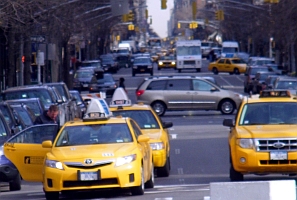A computer simulation developed at Tel Aviv University in Israel incorporates human behavior data with traffic statistics to determine environmental features that lead to black spots, intersections that experience a high incidence of traffic accidents. Environmental science Ph.D. student Gennady Waizman and colleagues discussed the SAFEPED model in July at the Geocomputation 2011 conference in London.
In the SAFEPED model, each car and pedestrian is considered an autonomous agent, with the ability to reason and react based on its individual predictions of how surrounding agents will behave. Other traffic models, says Waizman, do not always give each actor the ability to predict the actions of others and react accordingly.
Waizman’s team added this capability to the simulator based on a theory of visual perception developed by the cognitive scientist James J. Gibson, which posits that humans analyze their “optic flow” as they move through their environment, taking into account their anticipated time of collision with other objects or people.
In terms of the SAFEPED model, this means agents slow down, accelerate, or divert, depending on what they perceive and predict. SAFEPED can then permit engineers to test and rearrange the architecture of a planned junction and design it for optimal safety; see animation video below.
The behavior of the agents in the model is guided by Israeli traffic data, supplemented by first-person observations of fellow student Eilon Blank-Baron, who recorded videos of intersections from two cameras, analyzed the behavior of the moving drivers and pedestrians, and integrated the resulting data into SAFEPED.
The research has already led to some practical findings. SAFEPED indicates that the probability that pedestrians will cross a busy road is based on how they estimate the velocity of an approaching car. If they believe the car will cross the intersection in less than 2.5 seconds, people will not cross. At 5.5 or 6 seconds, however, most people will cross the road.
Also, SAFEPED data suggest that the position of a traffic stop line in an intersection can influence the likelihood of a pedestrian being hit. The further back a white stop line is set in an intersection, the smaller the chance that a pedestrian will be struck by a car at that corner.
Read more: Process Devised to Verify Safety of Assisted Driving Systems
* * *


 RSS - Posts
RSS - Posts
[…] Simulation Improves Safety at Traffic Intersections […]
[…] Read more: Simulation Improves Safety at Traffic Intersections […]
[…] Read more: Simulation Improves Safety at Traffic Intersections […]